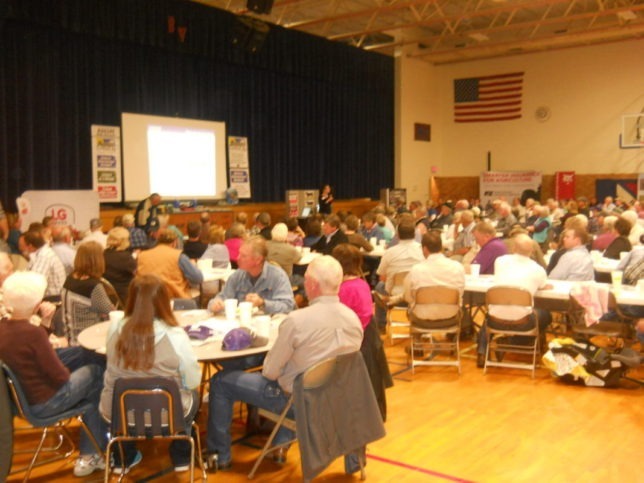Crop and livestock values are down sharply from recent years’ peaks, but land prices and rental rates paid by farmers have generally not followed trend.
That’s certainly true when looking at the numbers percentage wise, according to Dr. Mykel Taylor speaking to the crowd attending a recent Farm Profit Conference at Randolph.

Some reported land sale prices remain as high as ever, or even setting records, while most rental rates paid by farmers and ranchers have not come down, said Taylor, assistant professor in agriculture economics at Kansas State University, Manhattan.
More than 200 farmers and ranchers from a 100-mile radius filled the Blue Valley High School auditorium for a beef supper and the agricultural management program hosted by 580 WIBW in cooperation with the Riley County Extension Service.
In her “Kansas Farm Economy Update,” Taylor said, “Rental rates and net farm income are an indicator of short-run profitability in the ag sector, while land values are a gauge of long-run prosperity for agriculture and other businesses.”
Additionally, interest rates, access to credit, strength of the dollar and world trade have a wider economic impact, the speaker said.
A colored chart displayed on the overhead screen revealed returns to farmer growing four grain crops in north central Kansas from 1999, through 2013.
With the exception of strong wheat production profits in 2002, all other grain produced losses, or very minimal profits, until 2007, according to the Kansas Farm Management Association numbers.
Production of all crops was profitable from 2007 through 2013. Soybean returns were highest in 2009, and the most profitable crop to grow in three years during the period, while corn was the most profitable crop in 2010. Wheat production was a losing operation in both 2009, and 2010.
“Returns to farmers dropped sharply for all four crops in 2014,” Taylor pointed out, with the losses for corn farmers sharply lower than at any time in the previous 16 years.
“When and how will we adjust to the new level of non-profitability?” Taylor asked the farmers.
The question of when is driven by commodity prices. “If grain prices stay low enough long enough, the entire agriculture sector will have to adjust,” Taylor said.
“Options for adjustments,” she continued, “include less machinery turnover, reduced use of inputs and negotiating for lower land rents.”
Charts verified that cash rent for irrigated land in north central Kansas had declined on the average from a high of $140 an acre in 2013, to $124, last year. However, average non-irrigated land rent in north central had continued upward to a record high $58 per acre last year.
Likewise, pasture rental rates in north central Kansas peaked at $20 an acre last year, with only small fluctuations, ending higher, during the past decade.
Farmers should not be paying as high rental rates this year as last year, the economist emphatically pointed out. “But, most farmers are not paying lower rents,” Taylor stated.

Reason for this is that residual cash from higher revenue years will allow farmers to remain competitive longer. “Neighbors with more carryover cash will keep bids high,” Taylor insisted. “However, adjustments will occur if commodity prices remain low.”
One dilemma in the equation is that most rental contracts in Kansas average three to five years. “Farmers are locked in for the short run, but essential adjustments will be made as the contracts are renewed,” Taylor assured.
Pasture rates in the River Valley Extension District of Clay, Cloud, Republic and Washington counties during 2015 ranged from a low of $11 an acre to a high of $54, with an average of $27.22. For a 5-1/2-month grazing season, pairs were grazed on an average of 6.2 acres, while stocker cattle averaged 3.2 acres.
A colored map of the United States showed Kansas’ cropland valued at an average of $2,210 per acre in 2015, down 2.2 percent from a year earlier.
Several states had lower farm ground values, while some remained near steady, but cropland values were up 9.5 percent in Texas, and 8 percent in Oklahoma.
Due to continued cattle profitability last year, Kansas pasture land values averaged up 6.9 percent, to $1,390 per acre.
Interestingly, rent-to-land value was 1.4 percent for pasture, 2.8 percent for non-irrigated land and 3.8 percent for irrigated crop land.
“Actual land sales are not falling off as quickly or dramatically as we expected,” Taylor said.
Looking into her crystal ball, Taylor said, “Interest rates are low, but rising as the Federal Reserve Bank is slowly raising rates, while negative interest rates in other countries continue to affect our nation.”
Demand for the U.S. dollar is rising, and higher interest rates here will attract foreign funds. But, the strong U.S. dollar will reduce exports, because wheat will be cheaper in Australia, Canada, Russia and the Ukraine, according to Taylor.
Doomsayers have sometimes felt the economic downturn of the 1980s could be repeated now. There were high interest rates, a recession that hurt domestic demand, and President Carter’s Russian embargo on Ag commodities.
Land values fell off quickly, because only a small increase in the percentage of farm acres put up for sale floods the market, and a decrease in land equity reduces financing options, which can “exacerbate a bad situation,” the economist said.
However, Taylor clarified: “Many of those ’80s conditions are not the same today. But, we are obviously experiencing a contraction, and the speed of adjustment will largely dictate overall outcome.”
The economist urged: “Work with the landowner to negotiate rental rates that reflect current conditions, but still benefit both parties. Work to adjust rental rates frequently.”